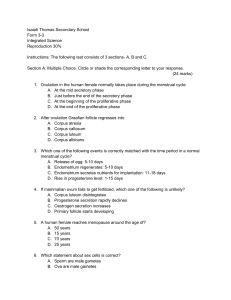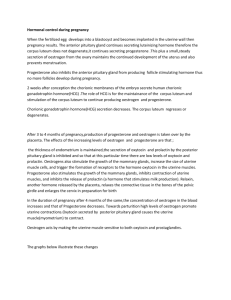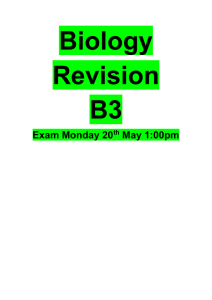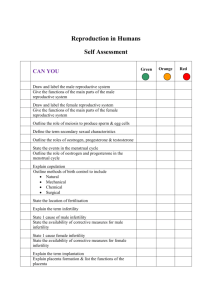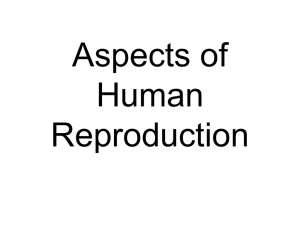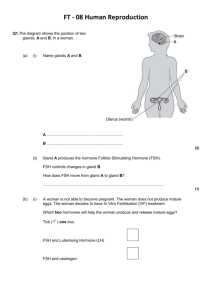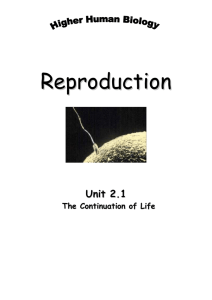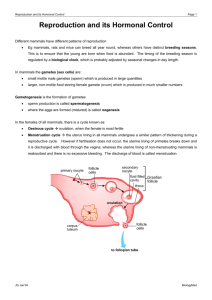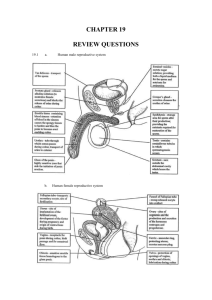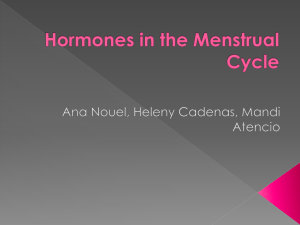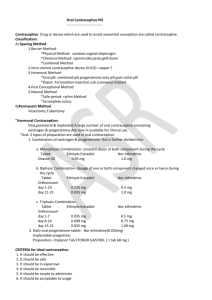Control of the Oestrous Cycle
advertisement
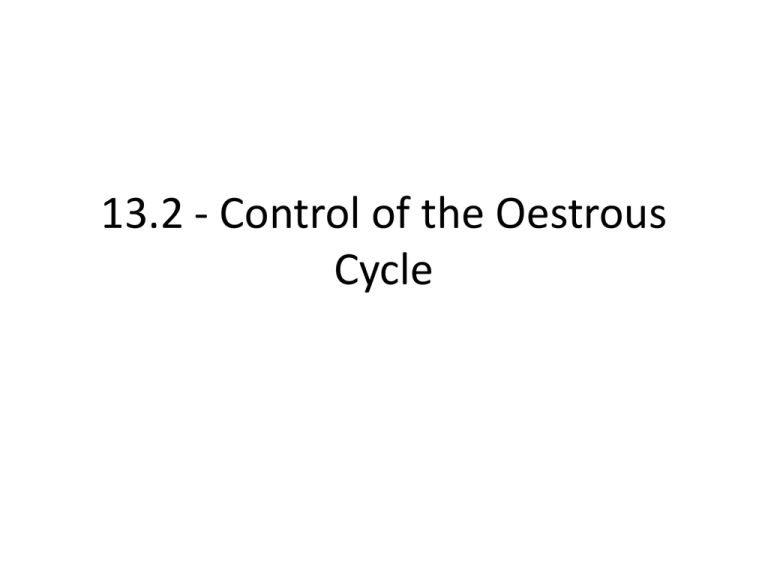
13.2 - Control of the Oestrous Cycle Learning Objectives • Learn which hormones are involved in the control of the oestrous cycle. • Learn how these hormones interact in the control of the human menstrual cycle. • How are different forms of feedback loop involved in this control? Oestrous Cycles • The reproductive system of mammals undergoes a regular pattern of changes. • As a species-wide phenomenon, this pattern is known as the oestrous cycle. • In human females, the oestrous cycle is initiated at the onset of puberty, continuing until the menopause. • In primates, the uterus lining is shed between each cycle. • Therefore the name we give to this special case is, the menstrual cycle. • The menstrual cycle is controlled by 4 different hormones, which interact with each other. Introduction to the Hormones • Follicle-Stimulating Hormone (FSH): This hormone stimulates the development of follicles in the ovaries. It in turn stimulates the follicles to produce oestrogen. • Luteinising Hormone (LH): This hormone triggers OVULATION. It’s second function is to then stimulate the corpus luteum to produce progesterone. • Oestrogen: This hormone rebuilds the uterine lining (endometrium) after menstruation. It also stimulates release of LH, by the pituitary. • Progesterone: Maintains the uterine lining in readiness for a fertilised egg. It also inhibits the production of FSH by the pituitary. Human Female: Menstrual Cycle – PART 1 • We take the beginning of menstruation as the start of the Oestrogen has 2 effects: menstrual cycleto(Day 1). 1. It binds oestrogen receptors on the cells of • The lining of the uterus: the endometrium, passes through the the uterine wall – causing them to REPAIR cervix and vagina over 4-5 days. and THICKEN. • The inner layer of endometrial cells is conserved so that a new layer can form by mitosis (later in the cycle). • • • 2. It has FEEDBACK EFFECTS on FSH and LH. At the time AMOUNTS, (Days 1-5) the pituitary gland will release FSH. Insame SMALL oestrogen INHIBITS FSH is responsible for stimulating the development release of FSH and LH. of follicles, whose cells then start to divide, resulting in growth. In LARGE AMOUNTS, oestrogen PROMOTES the As the follicle grows, it begins to release oestrogen. release of FSH and LH. Human Female: Menstrual Cycle – PART 2 • Early on, (days 5-10), oestrogen is released slowly, and therefore inhibits the release of FSH and LH. Hormone: • This will obviouslyLuteinising inhibit the development of other follicles. This hormone triggers Ovulation. • However, at day 10, the follicles are quite large and developed, and so there is a surge in the production oestrogen. It transforms an empty follicle of into the CORPUS • When the levels reach a critical point, oestrogen has a POSITIVE LUTEUM. EFFECT on FSH and LH, leading to a rapid release of these 2 hormones at around days 12-14. • It also stimulates the production of Due the release of LH, ovulation occurs at day 14, releasing the PROGESTERONE. egg. • Now that the follicle is empty, LH tranforms it into a CORPUS LUTEUM. Human Female: Menstrual Cycle – PART 3 PROGESTERONE: • The corpus luteum produces PROGESTERONE and oestrogen Progesterone has 2 main effects... during the second half of the cycle. • From around day 15, the levels of progesterone rise, peaking at 1. Its makes the uterine lining highly about daypresence 21. receptive to an embryo at days 20-21. • The levels of progesterone depend on whether the oocyte was fertilised a sperm or not. effect on FSH and LH. 2. Itbyhas a feedback • If it was fertilised, the embryo itself, will produce chemicals that At LOW levels, it has a negative effect on FSH, so will cause levels of progesterone to fall, which as you now know, nd half of now new follicles are stimulated in the 2 will inhibit FSH. cycle. • If it was not fertilised, levelsthe of progesterone will remain high for a while, inhibition (negativeeffect feedback). At HIGHcausing levels, it has ofa LH negative on This LH.will And eventually restrict blood flow to the endometrium, causing it to since LH stimulates the corpus luteum to produce break down – menstruation. progesterone, it has a negative effect on itself.
